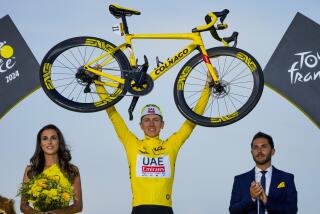Now Going Full Cycle, LeMond Has Become Tour’s Top Spokesman
PARIS — The big wheels keep on turning, beyond Lyon’s congestion, through champagne country, over fairly level terrain 131 miles from Villeurbanne toward Dijon, followed by an eight-hour muscle-cramper ending with a sprint into Reims. The mountains, the even meaner streets, they will come later.
And, no matter what place he is in, the man being chased is Greg LeMond.
Already he has had a flat tire and a stolen bike, occupational hazards of a kind, with the 78th Tour de France not yet a week old. Yet any of the 197 other riders who began this spokin’ safari cannot help but keep an eye on the American.
Attempting to win the world’s greatest bicycle race for the fourth time in six years, LeMond last Saturday told the starting-line onlookers in Lyon exactly what they wanted to hear: “I’m ready, as ready as I’ll ever be.” The festive, heavy-spending crowd was such that the politicians of France’s third-largest city felt gratified by their decision to pay $1 million for the privilege of being the launching pad for this year’s race.
It was nearly 90 degrees when LeMond took off for the prologue of the 2,447-mile race.
“I hate this part,” joked LeMond, and off he pedaled to the cheers of those who would be greeting him July 28 at the finish line in Paris as if he had come to the city to liberate it.
In between, the American faces 18 steep and mighty climbs, some in the Pyrenees, more in the Alps, on a carbon-fiber bicycle in unpredictable weather. There are times when the heat is positively oppressive and times when the leader’s yellow jersey comes in handy for warmth and protection in a cold rain. No map assures a rider of everything that lies ahead.
The strain can get you early or late. Stephen Roche, the Irishman who won the Tour de France in 1987, lasted only one day this time, undone by stomach cramps and a late start. LeMond once wondered if his skills as a cyclist had deteriorated until he discovered that a virus had been lowering his white blood-cell count, lowering his resistance to colds.
He nearly quit the sport altogether two months before his spectacular come-from-behind Tour victory of 1989. And it wasn’t simply because LeMond was still carrying inside him 30 shotgun pellets from the April 20, 1987 hunting accident on a ranch near Lincoln, Calif., which left him with a collapsed lung, punctured kidney and liver, and damage to his intestine and diaphragm.
No, Greg’s confidence was hurting. Not only was he racing poorly, but somehow he had even managed to offend the dignity of certain purists who said that it was OK for a rider to die, but only with his helmet on. When a Belgian cyclist and a Spaniard were killed in separate races, LeMond said, they were complimented “as if they had died nobly for some cause, but I got just what I deserved because I shouldn’t have been hunting.”
Promoters threatened to sue him for dropping out of races. His 1986 tour victory began to acquire a tarnish as a fluke. LeMond’s sponsor, the wealthy Dutch PDM team, deserted him. At a 1987 race in Ireland, when he lagged near the back of the pack, riders from other teams passed LeMond and laughed in his face. Even his eating habits were criticized, as though his comeback was being slowed not by the two shell fragments in the lining of his heart but by the rum-raisin ice cream in the lining of his belly.
Now, having turned 30 in June, LeMond is back on course. He is the kind of athlete whose idea of a workout is a 1,500-mile bike ride from Sacramento to La Paz, Mexico, which he did in January. Where others crumble, as in Tuesday’s 178-mile fourth stage of the Tour de France, its longest leg, LeMond remained strong. Oh, he suffered some when an opponent broke from the pack through a vineyard outside Reims, but LeMond ended the day within 10 seconds of the leader.
Before this Tour, LeMond took stock of his ambition to become the fourth man to win the event five times, which presumably would give him enough fulfillment to hang his bike on the garage wall for good. LeMond and his wife, Kathy, live on Lake Minnetonka outside Minneapolis part of the year and in Belgium and France during the other parts, and they have a 20-month-old daughter, Simone.
“I’m definitely always going to be the favorite for the Tour now, because I have the best track record,” LeMond said. “I’m confident that if I don’t have any injury, stay healthy and do the program I’ve planned, then I’ll be the one everybody will have to beat.”
It’s all downhill from there.
More to Read
Sign up for Essential California
The most important California stories and recommendations in your inbox every morning.
You may occasionally receive promotional content from the Los Angeles Times.










